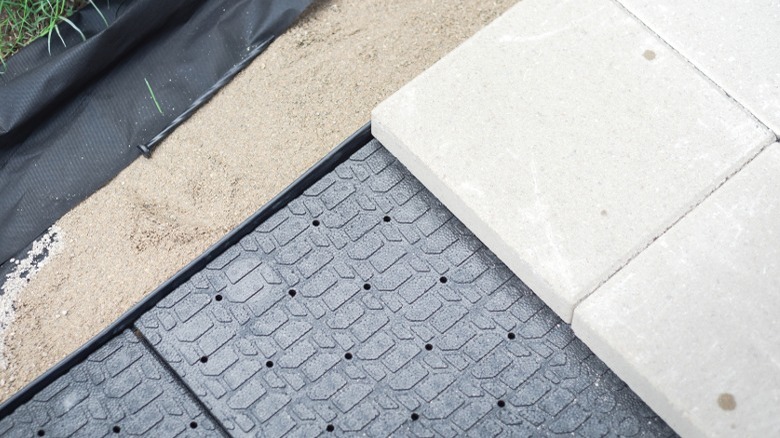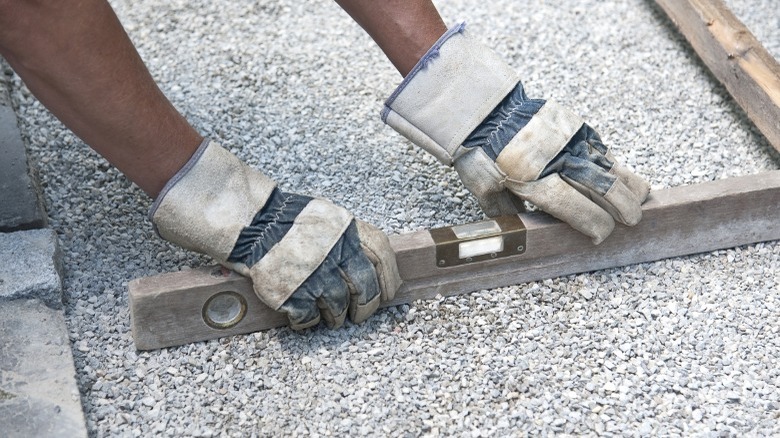Are Paver Base Panels Or Gravel The Better Choice For Your Patio Project?
Creating a unique patio space is one of the most fulfilling DIY paver projects you can tackle, especially now that there are so many convenient products to make it faster and easier. Typically, a patio project can feel overwhelming as you learn all that's involved. Before you get into the fun of choosing your paver patterns and laying them out, there's plenty of prep work needed to make a sound surface. You have to dig the soil, apply thick layers of gravel, and add sand, all while accounting for issues like drainage and weeds to make your layout last. With all the time, tools, materials, and know-how involved, it's easy to see this DIY transform into a job best suited for professionals. But thanks to paver panels, you can eliminate many of these steps and enjoy a more user-friendly path to a sturdy and stunning patio.
Paver panels allow you to skip the gravel layer step, saving you from deep digging and extra material costs. The recycled plastic panels interlock to create a flat, durable foundation for a paver overlay. Though they're often more expensive than crushed gravel, the time and effort you save make them much more valuable for DIYers wanting the shortest route to a quality installation. Still, gravel is the traditional method, and for many purists and professionals, nothing less than a crushed rock base will do. So, which is best for your paver patio?
Paver panels can make any patio project easier
The most popular paver panel brands are Brock PaverBase and Alliance Gator Base, both of which boast key features for long-term use. The panels are roughly ½-¾ inch thick and consist of polypropylene, a long-lasting and lightweight plastic. Each covers 5–6 square feet and disperses the load to manage several hundred pounds of weight. Alliance Gator Base claims the panels can hold up to 1152 pounds on a single square foot of paving blocks! The pieces interlock with surrounding panels via a tongue-and-groove design and are easy to cut with a utility knife for fast installation. Channels on the surface and holes spaced every few inches allow water to drain. Pavers can subsequently resist shifting to help you avoid dips and other common paver patio hazards.
By choosing paver base panels, you lose the need to dig an extra 6 inches into the ground to make a gravel layer. You only need to dig your soil, lay landscaping fabric, put down and level a layer of sand, and add panels before the pavers. You'll avoid hours of extra work and potential digging issues stemming from hard soil or underground pipes and lines. Plus, there won't be any worry about laying or leveling the gravel, saving you on materials, delivery, and labor. Each panel can replace about 150–280 pounds of gravel. According to Brock PaverBase, panels also have insulating properties similar to EPS used in homes, letting them relieve pressure and prevent damage from frost heave during the colder months.
Ever-reliable gravel supplies a lifetime of use
Paver panels are an excellent choice for most DIY patios and can be the most cost-effective depending on material costs where you live. For larger areas or in spots where maximum drainage is a concern, though, you may be better off with traditional gravel. Appropriate gravel is free-draining, compacts nicely, and remains flexible for managing freeze-thaw cycles. Alongside its efficiency, it could also end up being the more affordable solution.
At about $2–$2.50 per square foot, paver panels are a low-cost choice for smaller installations. But in some areas, such as southern states, where gravel is readily available and often better-priced, loose rock fill may be less expensive and more practical if you can put in the work. Gravel can also be ideal for larger, more resilient installations. PaverBase doesn't recommend their panels for driveways because of the weight limitations. Ultra Base is one product that can stand up to heavier items and traffic, but higher costs come with the superior strength. And beyond the cost considerations, panels may even be redundant in particular applications. For instance, the YouTube channel I Am a Hardscaper explains how raised patios that already need gravel fill to bulk them up wouldn't benefit from the extra layer. At a certain point, it makes sense to stick with gravel. There's no doubt that paver base panels are a game changer. But before settling on the easiest solution, it always pays to take the time to compare to ensure you're setting your patio up for lasting beauty and quality performance.

